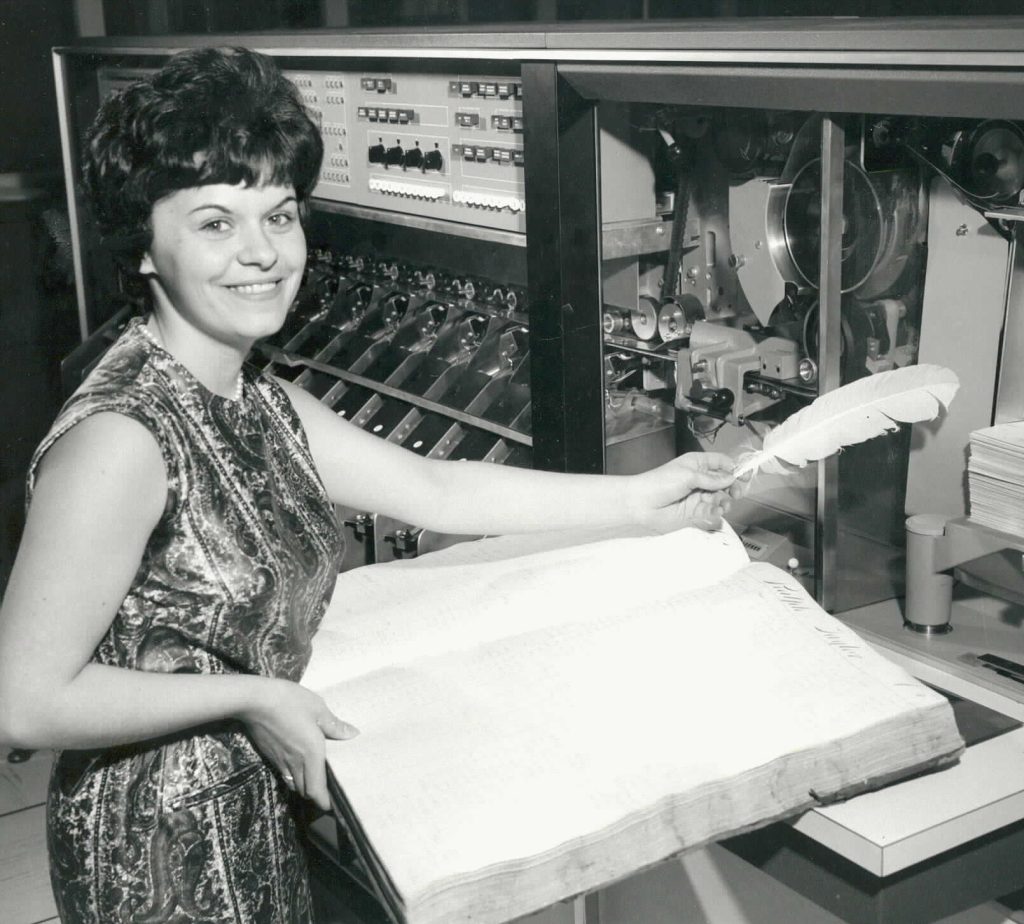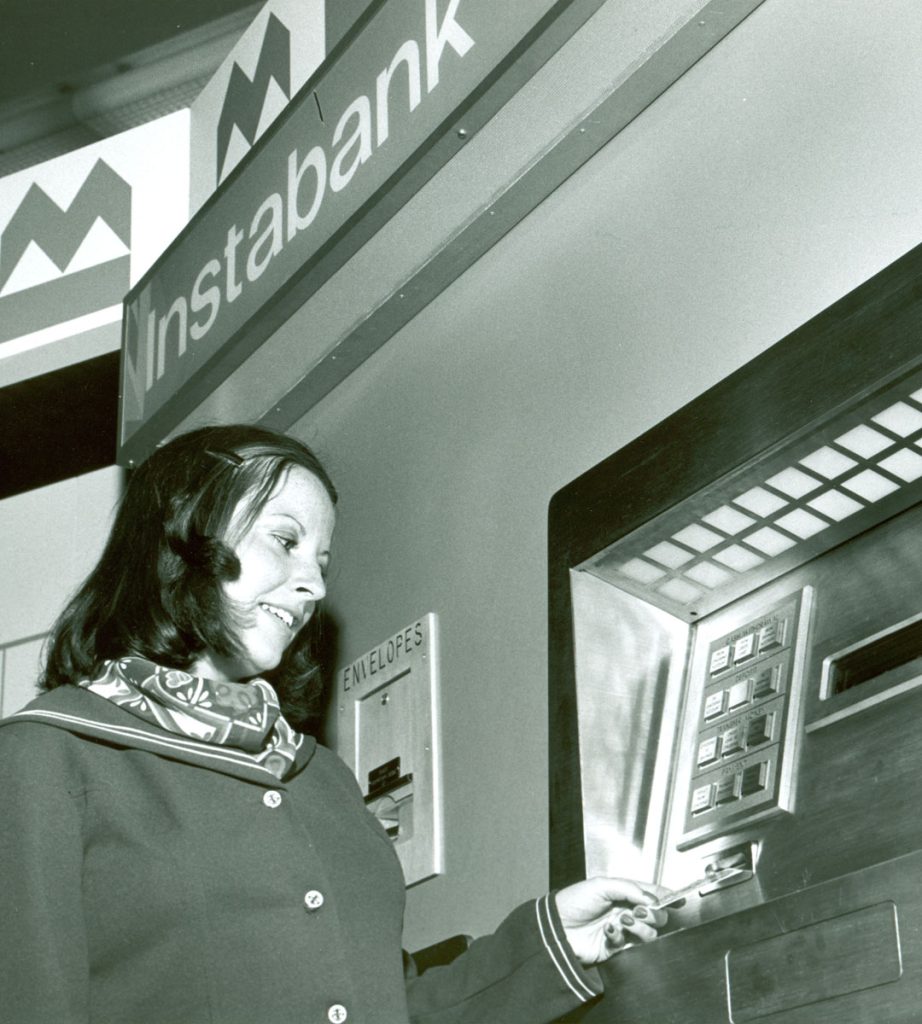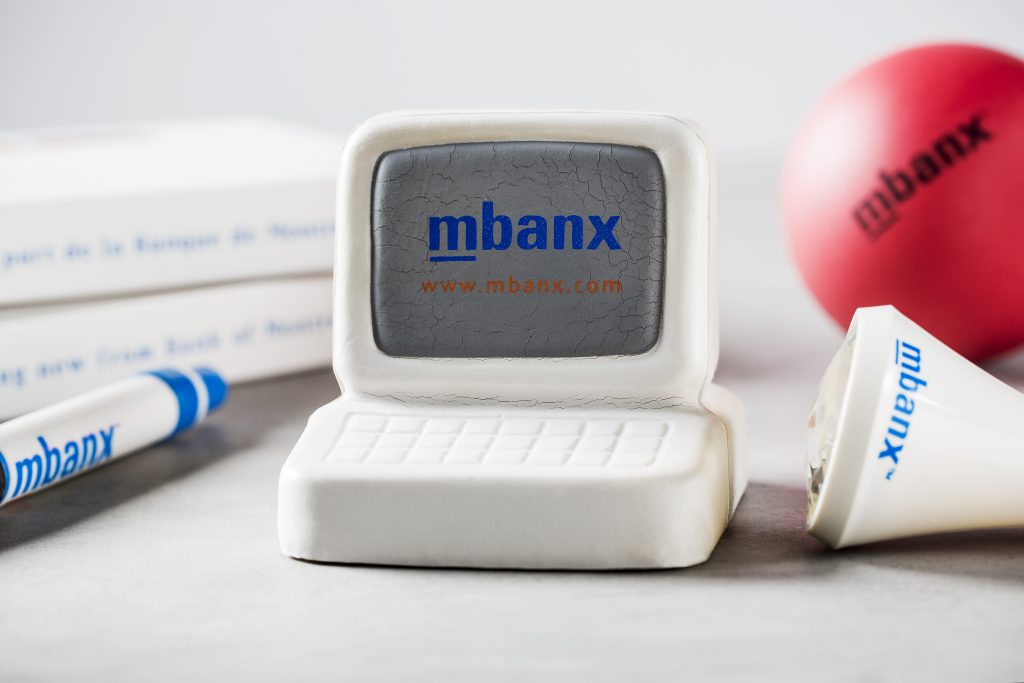
Exhibits
The Corporate Archives curates physical and digital exhibits from our collections to tell BMO’s story over the years. Our aim is to provide a better understanding of the defining moments in our history.
Innovation in banking
From opening Canada’s first drive-in bank to launching North America’s first full-service Internet banking system, BMO has been at the forefront of technology, helping our customers make real financial progress through industry-leading innovations. The instruments, processes, and systems of banking have evolved throughout the bank’s history, making way for more efficient and modern tools of the trade. Here is a sampling of some of the services and equipment that’s helped us serve our customers.

1820 – Remember passbooks?
An innovation in customer convenience, this small document passed routinely between customer and teller after each transaction – hence the name. Bank of Montreal’s archives has passbooks that date as far back as 1820 – three years after the establishment of the bank.
Image: Various BMO passbooks from different time periods.

1840s – Quill cutter
Prior to sharpening pencils, the quill cutter was used for cutting quills (feathers) to be used as pens.
Image: A quill cutter, c.1840.

Wax Seal
Important documents would be affixed with a wax seal in order to ensure authenticity.
Image: Bank of Montreal Pendant Seal engraved with the bank’s coat of arms, c. 1840.

1930s – Typewriter
Before computers came typewriters, which were often difficult to operate and came with a manual to “read before you write”.
Image: Remington typewriter, c. 1930.

1949 – Banking in cars
In September 1949, the bank received unprecedented national media coverage for the introduction of “Drive-in Banking” at the 10th and Granville branch in Vancouver. It was the first drive-in bank in Canada – and another example of the Bank of Montreal’s drive to be first. Drive-through ATM access has since become a common feature among North American banks.
Image: Photograph of customer using a drive-in banking wicket, c. 1950s.

1950s – Security around the clock
The installation of around-the-clock depositories in the 1950s provided an additional measure of security and convenience to customers, eliminating the risk of loss or theft of cash held overnight on client premises. The depositories were part of a larger movement in the post-war period to constantly improve business services for customers.
Image: “Cash in anytime,” advertisement for night deposits, c. 1950s.

1952 – Banking for children
In 1952, the Bank of Montreal became the first bank to have a children’s wicket where youngsters could make transactions (usually deposits, and usually held in trust). Children also received a passbook, which was aimed at helping to instill a sense of the value of money, savings and thrift in the younger generation.
Image: “It’s got my name on it and everything,” advertisement for children’s passbooks, c. 1950.

1953 – The magic of GENIE
On Canada Day 1963, BMO announced the launch of its first fully integrated automatic banking system: GENIE (GENerating Information Electronically). The first of its kind in Canada, this early data processing unit operated using magnetic ink character recognition. It could post 3,000 banking transactions per minute.
Image: Photograph of a BMO employee standing in front of a cheque sorting machine with a quill and ledger to show how far technology had come, GENIE Centre, 1963.

1958 – Semi-electronic bookkeeping
With the adoption of NCR (National Cash Register) technology, posting and chequing operations took less than half the time needed under former methods and provided customers with a “neat and uniform statement.” This innovation was part of the continuous process of search, adaptation, and improvement of the bank’s key technological systems.
Image: Page from a BMO Staff Magazine article on electronic bookkeeping, c. 1958.

“Sidewalk banking”
In 1958, a Bank of Montreal branch in Saint-Lambert, Quebec installed Canada’s first “walk up teller wicket.” The new service allowed customers to do their banking without even entering the branch.
Image: Photograph of customers using a walk up teller wicket, c. 1960s.

1968 – Bancardchek: The cash card
In the late 1960s, the bank introduced a unique new international service that combined the benefits of carrying cash and travellers’ cheques.
The Bancardchek, exclusive in Canada to Bank of Montreal at the time, allowed customers to carry secure guaranteed cheques. A matching signature on the customer’s Bancardchek card and Bancardchek was required for merchants to cash their cheques.
Unlike travellers’ cheques, the customer did not pay in advance, and was only charged if the cheques were used. The Bancardchek was one way the bank responded to the changing needs and lifestyles of customers.
Image: Advertisement for Bancardchek, c. 1968.

1969 – MECH
In 1969, Bank of Montreal announced a five-year program to create an online network of branches with real-time connection to a central computer. The system was hailed as the “most revolutionary development in the history of Canadian banking and a world first in terms of its scope.”
The new system connected 1,100 branches, spanning six time zones, via communications terminals linked to a large central computer – the IBM System/360 Model 65 located in Toronto.
MECH gave the Bank of Montreal the largest banking terminal network in the world. The enhanced efficiency offered convenience for customers, and provided branch personnel with expanded capabilities that enabled them to concentrate on helping customers make real financial progress.
Image: Photograph of Bank of Montreal employee explaining to bank directors how Genie Centre machines operate, Genie Centre, Montreal, 1963.

1970s – The dictograph
This piece of telecommunications technology was once used in the executive suite of the bank’s Montreal head office. It functioned as a supplementary intercom system to provide a direct connection among a small number of executives. The call button labels indicate that this machine served the top decision-makers of the bank in the late 1970s.
Image: Dictograph machine, c. 1970.

Steel Teller
The Steel Teller was introduced in Quebec in the late 1970s. Customers could drop deposits, bills and passbooks into the mailbox-like structure, and branch personnel processed the transactions after hours. The passbooks and receipts were then mailed back to the customer, helping reduce lineups at the branch and saving the customer valuable time.
Image: Photograph of customer demonstrating the use of a steel teller, c. 1970.

The little bank that's always open
The Instabank machine was a significant innovation in customer convenience, providing 24/7 access to automated banking services, including cash deposits and withdrawals, bill payments, money transfers, and more.
Introduced in the mid-1970s in Toronto, Calgary, and Vancouver, Instabank machines also allowed customers to request that a bank representative contact them by telephone or mail.
Image: Photograph of customer using an Instabank machine, c. 1970s.

1973 – BMO brings MasterCard to Canada
In 1973, Bank of Montreal entered the Interbank Card System, or the charge card system, with the Provincial Bank (later National Bank) under the name of Master Charge. At the time, Canada was one of the key world markets in this new technology.
The bank opted for Master Charge because it was the world’s best-known and accepted all-purpose bank charge card at the time. Master Charge became what is now known as Mastercard.
Image: Photograph of a MasterCard swiper, the original method used to process credit cards, c. 1970.

1976 – Tyme Machine
In 1976, M&I introduced Wisconsin’s first automated teller machine (ATM).
Image: Photograph of M&I’s Tyme Machine, c. 1976.

1979 – Multi-branch banking becomes a reality
BMO was the first bank to introduce multi-branch banking in Canada. Addressing the bank’s Annual Meeting in 1979, President W.D. Mulholland stated, “For the first time, any customer of the Bank of Montreal will be able to go into any on-line branch in Canada, make deposits and withdrawals and obtain the balance in his account just as if he were in his own branch.”
Image: Instabank machine, c. 1980s.

TV teller
In February 1979, Bank of Montreal’s Winnipeg main branch opened television tellers in its concourse level. These new tellers connected customers and bank employees through four colour TV screens with telephones. Transactions were carried to and from customers via pneumatic tubes. These tellers were intended to attract young professionals walking to and from work.
Image: Customer using a TV teller, c. 1979.

1983 – Canada’s first home-banking service
In 1983, Bank of Montreal was the only bank in Canada to participate in a bank-at-home research project, which enabled select customers to make transactions at home, using a keyboard computer terminal attached to their TV set and telephone. The service was created with farmers and rural business owners in mind, allowing them to access their account information no matter how far they lived from their Bank of Montreal branch.
Image: Photograph of a keyboard computer terminal for at-home banking, c. 1983.

1984 – Cirrus
In 1984, Bank of Montreal was the first Canadian bank to announce plans to link its network of automated banking machines (ABMs) to another network of ABMs though Cirrus (an American ABM network at the time, which has since become global). This new compatibility allowed BMO to better serve customers throughout North America.
Image: Advertisement for the new Cirrus service, 1984.

1988 – InvestorLine
In 1988, Bank of Montreal launched a self-directed investing service for clients. Then, in 2000, the bank offered self-directed investing online. Since then, InvestorLine has grown into an award-winning investment service for Canadians.
InvestorLine provides leading-edge, innovative tools and client-focused support to help clients make progress toward their goals. The service provides access to research from independent industry leaders, and educational tools to empower clients to make informed and confident investment decisions. Its mobile and tablet apps give customers access to their accounts for on-the-go, anytime, anywhere banking.
Image: InvestorLine website, March 10, 2011.

1989 – A leader in EDI technology
In September 1989, BMO was the first bank to install an automated ordering process, along with Telecom Canada. The process used Electronic Data Interchange (EDI), which involved the electronic exchange of business documents, such as purchase orders and invoices, through computer-to-computer communication.
By the 1990s, BMO was recognized as a leader in electronic banking and had taken a proactive role in the development, implementation, and evolution of Canada’s financial EDI within the Canadian Payments System.
Image: Photograph of a BMO employee posing in front of the EDI logo, 1995.

1996- mbanx
In 1996, BMO launched mbanx, North America’s first full-service Internet banking system. mbanx was an entirely new virtual banking enterprise, designed to meet the needs and realities of time-pressed customers. The new system showed that BMO understood the potential of the Internet and was not afraid to push the boundaries of banking to innovatively serve our customers.
Image: Promotional items for the launch of the mbanx service.

2015 – Smart Branch
In 2015, BMO piloted Smart Branches, a small-format branch with enhanced technological capabilities.
Perhaps the most noticeable difference between a traditional branch and a Smart Branch is that you won’t find any bank tellers at the Smart Branch. Bank personnel are “wireless,” which allows them to move freely around the branch, offering increased assistance and interaction with customers.
At a Smart Branch, customers can be instantly connected by video to a bank representative through the “video-teller.” Depending on the customer’s needs, they may be directed to a specialist.
Image: Photograph of a Smart Branch ATM, c. 2015.

Mobile Cash
In 2015, BMO Harris Bank launched Mobile Cash, the card-less way to withdraw money. The technology allows customers to withdraw money from designated BMO Harris ATMs using their smartphone, saving time while enhancing security.

2016 – BMO SmartFolio
In 2016, BMO Wealth Management launched BMO SmartFolio, an affordable digital portfolio management service. BMO SmartFolio provides a digital and hands-off approach to investing that is aligned to clients’ objectives. While the service is digital, a team of expert portfolio managers make each investment decision. This powerful tool is another example of how our teams deliver leading products, platforms and advice that investors need to make progress toward their investment goals.
Image: Advertising for BMO SmartFolio, 2016.

Biometric security features
In 2016, BMO announced a phased launch of the first biometric corporate credit card program in Canada and the U.S., which enabled cardholders to verify transactions for online purchases using facial recognition and fingerprint biometrics.
